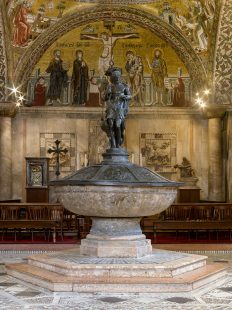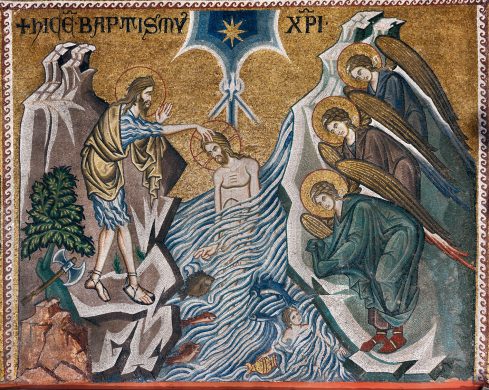Il Battistero
Il Battistero detto anticamente Giesia dei putti, ovvero Chiesa dei bambini, occupa uno spazio a sud della basilica, un tempo aperto verso la Piazzetta. È suddiviso in tre ambienti, l’antibattistero, dove i catecumeni attendevano il rito del battesimo, il battistero propriamente detto, e il presbiterio.
Poche e incerte sono le notizie relative a questo ambiente prima del suo attuale allestimento voluto da Andrea Dandolo, uomo di grande cultura amico di Francesco Petrarca, dapprima Procuratore di San Marco e poi Doge dal 1343 al 1354.
Una fortunata campagna di scavi, condotta dal proto Angelo Scattolin nel 1978, ha portato alla luce i resti di un’antica vasca battesimale ad immersione, in parte rivestita da affreschi, comprensiva delle condotte d’acqua, che sembra stabilire con certezza l’antica funzione di questa cappella. L’ambiente era decorato da affreschi venuti alla luce a più riprese: una prima volta nel 1889 durante il mandato del proto Pietro Saccardo sotto le lastre di rivestimento sovrastanti la tomba del doge Soranzo, affreschi che furono staccati e conservati nei depositi della basilica, e una seconda nel 1963 durante il mandato del proto Ferdinando Forlati nella parete alla sinistra dell’altare, rimasto in opera e tuttora visibile, che rappresenta l’Ascensione di Gesù.
L’altare è costituito da un enorme pietra di granito rosso, portato da Tiro dal Doge Michiel nel 1125 quale reliquia, in quanto si narra che su di essa Gesù abbia pronunciato il famoso discorso delle Beatitudini.
Il fonte battesimale, ideato da Jacopo Sansovino proto di San Marco dal 1527 al 1570, le cui spoglie riposano ai piedi dell’altare, è ornato da un coperchio in bronzo suddiviso in otto settori dei quali quattro presentano fatti della vita di San Giovanni Battista e i restanti i quattro evangelisti. Il coperchio venne realizzato nel 1545 da Tiziano Minio e Desiderio da Firenze. Nel 1566, sempre sotto la direzione di Sansovino, Francesco Segala eseguì la splendida statua in bronzo del Battista posta sopra il fonte battesimale.
La decorazione musiva sviluppa il racconto della vita di Giovanni Battista: la nascita, la predicazione, fino al martirio per decollazione magistralmente mosaicato nella lunetta nord nel mosaico Danza di Salomè. Nella zona dell’antibattistero, nella cui volta a botte sono raffigurati i profeti dell’Antico Testamento, la narrazione della vita del Battista scorre parallelamente a quella dell’infanzia di Cristo, per poi incrociarsi nella bellissima scena del Battesimo di Gesù nelle acque del Giordano. Nella lunetta est, nella parete sopra l’altare, Gesù e san Giovanni sono nuovamente riuniti nella scena della Crocifissione, raffigurati insieme alla Vergine, San Marco, san Giovanni Evangelista al doge Andrea Dandolo e al suo consigliere
Nella cupola sopra il fonte battesimale è rappresentato il mandato di Gesù agli apostoli che li invia nel mondo a predicare il suo vangelo e a battezzare le genti. Nella cupola sopra l’altare è rappresentato Cristo in gloria fra le nove gerarchie angeliche.
Alle pareti, riccamente rivestite di marmi, si trovano le tombe di Giovanni Soranzo, doge dal 1312 al 1328, e del doge Andrea Dandolo.
Nella parete dietro all’altare si trova il bassorilievo del Battesimo di Cristo affiancato dalle figure dei santi Giorgio e Teodoro.
Le tre porte danno accesso a nord all’interno della chiesa, a ovest alla cappella Zen e a sud alla Piazzetta.
Approfondimento: E. De Franceschi, I mosaici del Battistero, fra il rinnovamento bizantino-paleologo e la produzione pittorica veneta dei primi decenni del trecento, tratto da San Marco. La basilica di Venezia. Arte, storia, conservazione, a cura di E. Vio, Venezia 2019, Vol. I, pp. 309-317.


